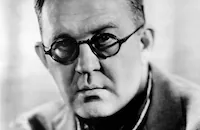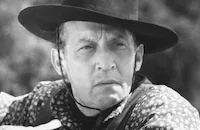Arrowsmith

Brief Synopsis
Cast & Crew
John Ford
Ronald Colman
Helen Hayes
Richard Bennett
A. E. Anson
Clarence Brooks
Film Details
Technical Specs

Synopsis
In a prologue, a young pioneer women drives a wagon West. In the main story, her great grandson, Martin Arrowsmith, is inspired by her pioneering spirit to become a medical student. As a young doctor, he desires to become a researcher, but his marriage to nurse Leora Tozer prevents his attaining the position he would like with Professor Max Gottlieb. Instead he goes with Lee to her small home town in Minnesota, where he becomes a country doctor. Despite the dull routine, Martin's brilliant mind keeps working and in a few years he discovers a serum to cure cows of Black Leg disease. His findings eventually lead to a position with Dr. Gottlieb at the McGurk Institute in New York. Lee has had a miscarriage and devotes herself to Martin, although his research keeps him away for long hours. When Gustav Sondelius, a scientist and friend of Martin and Dr. Gottlieb's announces that plague is raging in the West Indies, Martin goes to test a new serum he has developed, promising Gottlieb that he will only innoculate half of his patients in order to test his results scientifically. Lee accompanies him, despite Martin's concerns. On the island, the white citizens will not submit to his tests, but the natives, led by a Howard University-educated black doctor named Oliver Marchand, willingly cooperate with him. Martin must go to one of the other islands, leaving Lee alone. There he meets plantation-owner Lanyon and his daughter Joyce, who help him. After Sondelius dies from plague, Martin and Joyce go to bed together. The next morning he recives a call from Marchand, who has returned to the main island. When Marchand collapses from the plague, Martin hurries home, worried that Lee may also be infected. When he returns, she is dead, having contracted the disease through a cigarette carelessly placed in Martin's lab. Distraught, Martin drunkenly allows everyone to have the serum, destroying his scientific research. When he returns to New York, Gottlieb suffers a stroke and Martin decides to go with his co-worker, Terry Wickett, to Vermont to open a lab. Joyce offers her friendship to him, but he leaves, wanting to re-new his committment to pure research with Lee spiritually with him.

Director

John Ford
Cast

Ronald Colman

Helen Hayes

Richard Bennett
A. E. Anson
Clarence Brooks

Alec Francis
Claude King
Bert Roach

Myrna Loy

Russell Hopton

David Landau
Lumsden Hare

Dewitt Jennings

Beulah Bondi

John Qualen
Florence Britton
Adele Watson

Charlotte Henry

Ward Bond
Theresa Harris

Raymond Hatton
Crew

Photo Collections
Videos
Movie Clip





Film Details
Technical Specs

Award Nominations
Best Art Direction
Best Cinematography
Best Writing, Screenplay
Articles
Arrowsmith
At the McGurk, Arrowsmith's pioneering methods attract even greater notice. He soon decides to undertake his greatest project yet, testing a newly developed serum in order to find a cure for a more troubling malady: bubonic plague. Arrowsmith travels to the West Indies to test out a potential cure but finds some resistance to his methods from the white expatriates there who refuse to be guinea pigs in his experiments. Instead, with the help of a black doctor, Oliver Marchand (Clarence Brooks), Arrowsmith travels to an isolated island to inoculate its indigenous residents. While on the island, Arrowsmith meets and - in the thinly veiled shorthand of classical Hollywood cinema - has a liaison with another white Westerner, Joyce Lanyon (Myrna Loy). He also stands helplessly by as one of his esteemed colleagues, Sondelius (Richard Bennett), succumbs to the disease.
Arrowsmith's troubles intensify back on the mainland, where he finds he has inadvertently allowed Leora to contract the plague by leaving behind unhygienic laboratory conditions. [SPOILER ALERT] In a strangely downbeat turn for a Hollywood film of the time, Leora eventually succumbs to the disease.
Though critics of the time tended to find Colman's starring role as the conflicted, career-driven Dr. Arrowsmith compelling, writers in subsequent decades have not always been able to accept the British actor's innate sophistication -- and age -- next to the more homespun performance of First Lady of the American Theater, Helen Hayes.
Despite considering the role one of his best (until he made A Tale of Two Cities in 1935) Colman was not especially pleased to be working on the production. He felt that Samuel Goldwyn did not fit him into roles best suited to his talents. In addition, the actor so strongly disliked Goldwyn he dealt with him only through intermediaries.
As Colman told Hayes one day on set according to A. Scott Berg in Goldwyn, "What do I do? I just bring the body to the studio and say my lines." Colman's resentment for that and other crimes came out later when he sued Goldwyn for his publicity chief Lynn Farnol's indiscretion in letting slip to a movie columnist that Colman liked to drink liquor before performing his love scenes. Colman eventually dropped the suit.
Despite all of this, the film's director John Ford said of Colman, "He did everything so easily that no one acknowledged what a superb actor he was...but he was one of the greatest actors I have ever known."
Though born in Maine, John Ford identified strongly with his Irish roots, an identification that informed some of his greatest films (How Green Was My Valley (1941), The Quiet Man, 1952), but also fueled his combative personality which intensified when drinking. He initially came to Hollywood following his older brother Francis, an actor, writer and director in the industry. The younger Ford soon established himself as a masterful director, primarily as a maker of Westerns. Though he began directing in 1917, Ford would not achieve his greatest acclaim until the late '30s with iconic films like Stagecoach (1939) and The Grapes of Wrath (1940).
Outside his usual Western genre, Arrowsmith was a highly unusual project for Ford who was in between projects at his home studio, Fox. The studio was thus anxious to draw on their investment by loaning their director out to Samuel Goldwyn for Arrowsmith. It was Ford's first picture away from the studio.
Pulitzer Prize-winning dramatist Sidney Howard adapted Arrowsmith for the screen from the Pulitzer Prize-winning 1925 novel by Sinclair Lewis, the country's only Nobel laureate. Lewis later expressed pleasure with Ford's interpretation of his novel.
Ford's treatment was undeniably visually compelling, profoundly influenced by the moody, shadow-laced, expressionist direction of F.W. Murnau. The film was especially lauded for demonstrating that the new "talkies" could be visual equals to the silents they were replacing. Cited in many polls as one of the best films of 1931, audiences were pleased with the picture as well, and The New York Times called it one of the ten best pictures of the year. The film was Oscar® nominated for Best Adapted Screenplay, Best Cinematography, Best Art Direction and Best Picture, but lost to Grand Hotel (1931).
Actress Myrna Loy had a brief role in the film as the woman who tempts Arrowsmith momentarily away from his serums and medicine. Loy considered her introduction in the film - in which her lily white arm is seen amidst the black ones extended for one of Arrowsmith's inoculations - as an indication of Ford's attraction to her. Ford begins at her arm and then pans up to Loy's face, making her ravishing beauty the climactic payoff. Loy said of the scene in her autobiography Being and Becoming, "That was Jack Ford again, with his special thing for me--it wasn't overt, but I knew it was there. You can tell when a man has a yen."
Leading lady Helen Hayes, who also claimed Ford developed a crush on her, saw a different side to Ford. The director was under strict orders from Samuel Goldwyn to stay away from the bottle during the film's production. But Hayes writing in her own autobiography My Life in Three Acts, noticed that, despite the Arrowsmith production proceeding well at first, as the shoot continued, things began to change. "I noticed funny things were happening--pages of the script were being tossed out, entire scenes eliminated, all sorts of shortcuts taken--and why? Because he wanted to pare-away the days till he could have another drink."
The director and actress had a small showdown when Hayes threatened to tell Goldwyn if Ford made any more cuts to the script. But Ford would not be intimidated. As Hayes recounted, "You'll do as I tell you," he growled. "I'm the director of this picture. You're only acting in it."
Director: John Ford
Producer: Samuel Goldwyn
Screenplay: Sidney Howard based on a novel by Sinclair Lewis
Cinematography: Ray June
Production Design: Richard Day
Music: Alfred Newman
Cast: Ronald Colman (Dr. Martin Arrowsmith), Helen Hayes (Leora Arrowsmith), A.E. Anson (Prof. Gottlieb), Richard Bennett (Sondelius), Claude King (Dr. Tubbs), Beulah Bondi (Mrs. Tozer), Myrna Loy (Joyce Lanyon).
BW-100m. Closed captioning.
by Felicia Feaster

Arrowsmith
Quotes
Trivia
Notes
According to information contained in the MPAA/PCA file on the film in the AMPAS Library, the picture was approved in November 1931 without eliminations, even though the words "hell" and "damn" were included in the dialogue. A memo in the file from Col. Jason Joy of the Hays Office notes that the word "hell" was allowed three times in the picture because of its proper use within context, even though its use was "probably" in violation of the letter of the Production Code. Exception was taken to the line "It's hell on bugs," but the line was allowed. The picture was issued a certificate for re-issue on July 5, 1935. According to a letter in the file dated July 24, 1945, written by PCA director Joseph I. Breen to Gordon S. White of the New York office, Breen advised that when the certificate was issued in 1935, the words "hell" and "damn" were not in the print submitted by Samuel Goldwyn. Some time in July 1945, Nat Sanders of English Films, Inc. had complained to White that he had recently seen the film in New York at the Criterion Theatre and it "had more hells than I have hairs on the top of my head." Breen explained in the letter that the Criterion had most likely gotten an original print of the film and that Goldwyn had not recently re-issued the picture. He also indicated that Sanders, who represented English films which frequently had words such as "damn" and "hell" removed before certification, was probably annoyed at finding those words in an American film.
Arrowsmithm, which was based on Sinclair Lewis' Pulitzer-Prize-winning novel of the same name, received several Academy Award nominations, one for Sidney Howard for Best Adapted Screenplay, one for Ray June for Best Photography, one for Richard Day for Best Art Direction, and one for the film for Best Picture. Modern sources mention that H. Bruce Humberstone assisted John Ford on the picture and that Ford worked off the production briefly when he and Humbertsone had an argument about staging one of the scenes and producer Samuel Goldwyn sided with Humberstone. Modern sources also include James Marcus, Sydney de Grey, Pat Somerset, Eric Wilton, Erville Alderson, George Humbert, Walter Downing and Bobby Watson in the cast. Spencer Tracy and Fay Wray portrayed "Martin" and "Leora Arrowsmith" on a Lux Radio Theatre Broadcast on October 25, 1937.

Miscellaneous Notes
Released in United States 1931
Released in United States March 1975
Released in USA on video.
Released in United States 1931
Released in United States March 1975 (Shown at FILMEX: Los Angeles International Film Exposition (The Ides of March) March 13-26, 1975.)













